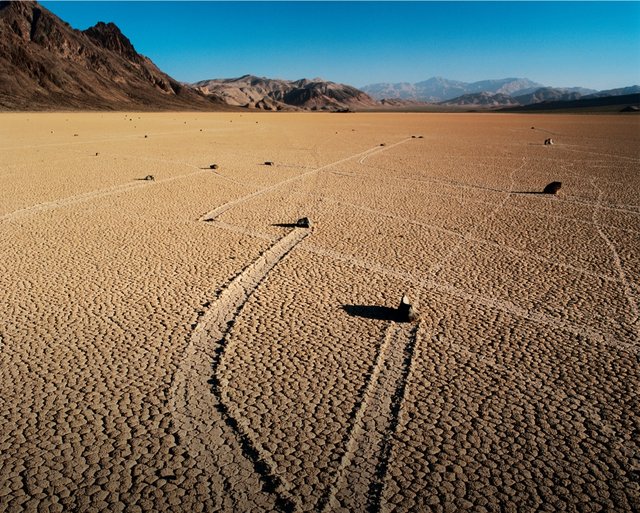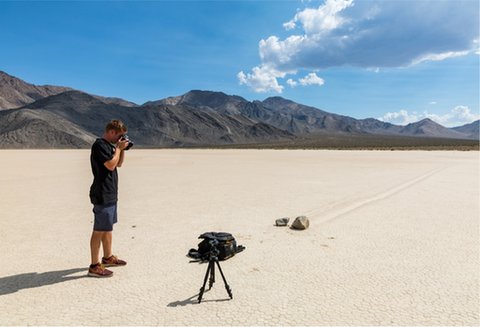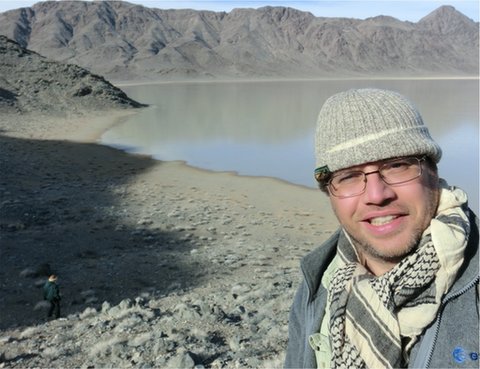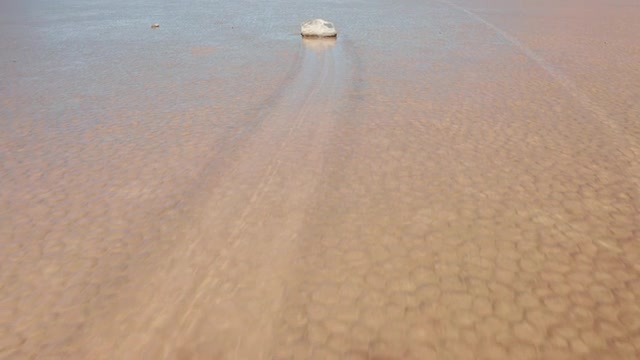
Abigbouldersticksoutofthedriedmud.Thisrockistooheavytopickup.Yet,ithasmysteriouslymoved.Afewdaysago,itwas250meters(820 feet)away.Atrailshowswhereitmovedacrossthe dirt.
Thisisn’ttheonlyrockonthemovehere.ManyoftherocksinthispartofDeathValleyinNorthAmericadon’tstayinoneplace.Theirtrailscrisscrossthecrackedmudofadried lake.
Someglideinstraightlines,thenstopandsettleintothedrymud.Somerocksmoveinpairs.Otherszigzagthiswayandthat,leavingajaggedtrail.Howdidthey move?
Noonehaseverseenit.It’samystery.
Bouldersmysteriouslyzigand zaginDeathValley,California, U.S.A.


North
America
Death
Valley

Amantakesaphotographofbouldersandtheir trails.
Searching
foraCause
Overtheyears,peoplehavecomeupwithwildwaystoexplainhowtherocksmove.Somepeoplesaytherocksaremagicalandmoveontheirown.Otherssayaliensfromspacearemovingthem.Stillothersthinkprankstersareplayingtricks,movingtherockswhennooneis looking.
Scientistswanttofindabetteranswerthanmagicoraliensorpranksters.Sothey’ve lookedforevidenceinnaturefor answers.
LookingtoNature
Anearlytheorywasthatgravitymovestherocks.Thisforcecouldtugontherocksandpullthemdownhill.Eventhoughthisarealooksflat,itactuallyslopesa little.
Soscientistslookedforpatternsinwhichdirectiontherocksmoved.That’swhenthegravitytheoryfellapart.Mostoftherockshadmoveduphill.Gravityisastrongforce,butitpullsthingsdown,notup.Anothertheorywasthatwindspushedtherocks.Thewindsherearestrong.Somegustupto113kilometers(70miles)perhourthroughDeathValley.Windstormscalleddustdevilsalso whirl.
Thescientistsdidexperimentstotestthewindtheory.Oneevenusedthewindfromaplanepropellertotrytomovetherocks.Thetestsshowedthatwindsaren’tstrongenoughtomovethebiggest boulders.
Thisvideofollowsthetrailmadebyaheavy stone.
ColdClue
Finally,scientistsnoticedthattherocksseemtomoveonlyinthewinter.That’swhenthisareasometimesfloods.Athinlayerofwatercoversitandsurroundsthebaseofthe rocks.
Studyingthewaterledscientiststonewtheories.GeologistPaulaMessinaobservedathinlayerofslimybacteriagrowinginthewater.Theslimemakesthegroundreallyslippery,sotherockscanslideeasily.Evenasmallwindmaybeabletopushthe rocks.
AnExperiment
ThewatergavescientistRalphLorenzadifferentidea.Hethoughtthatitmightgetcoldenoughin thewinterforringsoficetoformaroundtherocks.Sinceicefloatsonwater,theicemightlifteventhebiggestrocksalittle.Thenalightwindcould
push them.
Lorenzdidanexperimenttoseeifhistheoryworked.Hemadeamodelofhisidea.First,heputarockandsomewaterinhisfreezer.Assoonasaringoficefrozearoundtherock,heplaceditinatrayofwaterwithsandonthebottom.Therockfloatedalittlebit.ThenLorenzblewlightlyontherock.Itmoved!Itsbottomscrapedalongthesand,leavinga trail.
Soitseemsthaticeandwindcouldhelptherocksmove.Socouldbacteriaandwind.Boththeoriesarepossible.Yetnoone’severseentherocksmove,sothismysteryremains unsolved.

Scientist RalphLorenz standsnearafloodedareaofDeath Valley.
